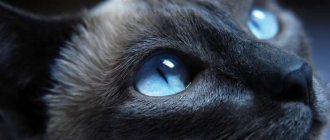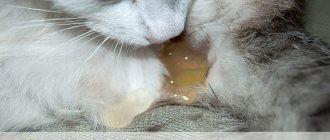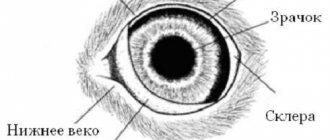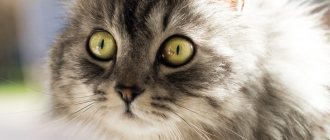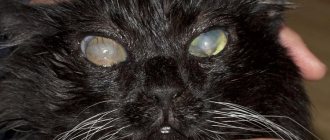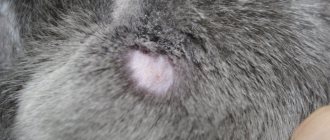A small amount of clear discharge is normal, but if a cat has brown discharge from the eyes, then this is an alarming signal that may indicate the development of some pathology. If dark discharge appears from a cat’s eyes and does not go away for several days, you should carefully observe the animal’s behavior, evaluate possible provoking factors, and seek help from a specialist.
Normal eye discharge
A cat's vision is much sharper than a human's. It helps her navigate space, hunt, quickly get acquainted with new surroundings and see in the dark.
It is normal for cats to secrete a small amount of clear fluid from their eyes. The discharge is odorless and almost colorless. Its quantity is quite scanty and has a semi-liquid consistency. It helps to cleanse the organs of vision from dust, foreign bodies (crumbs, tiny debris) and other contaminants.
In some cases, increased fluid separation is characteristic of certain breeds. For example, this is typical for Persian cats, in which the normal functioning of the nasolacrimal duct is genetically impaired.
It is also common for your pet to experience excessive tearing after sleep. The result may be an accumulation of so-called “sour marks” in the corners of the eyes, which the cat will remove on its own during hygiene procedures.
What kind of discharge is normal for cats?
A clear liquid that is barely noticeable on the fur is not a reason to worry. Animals, like humans, may experience watery eyes after waking up from sleep. If this is not the reason, the tear may have been caused by dust in the room, too bright light, smoke or some kind of chemical irritants.
This is what normal discharge from the tear ducts looks like
Important! In breeds with slightly bulging eyes, tears may flow because the cornea is drying out. If this is a Scotsman or another cat with bulging eyes, for example, a British cat, there is definitely no need to worry about a transparent drop noticed on the eye.
Causes
When a cat develops dark purulent discharge from the eyes, this indicates the development of some disease. Pathology can affect various organs and systems, and manifest itself with a similar symptom. Thus, dark discharge is a consequence of disruption of the body.
The most common causes of non-infectious discharge from the eye in a cat are:
- head or eye injuries;
- a foreign body caught on the cornea or in the lacrimal canal;
- allergy;
- pathologically narrow lumens of the lacrimal canals, which impedes the normal flow of fluid through them;
- dacryocystitis (obstruction of the lacrimal duct caused by congenital anomalies or an inflammatory process);
- congenital disorder of eyelash growth, which causes constant irritation of the cornea;
- benign and malignant neoplasms that mechanically affect the tear ducts, squeezing their lumen.
Dark and even black discharge from a cat’s eyes can occur as a result of infectious diseases:
- conjunctivitis;
- keratoconjunctivitis;
- blepharitis (inflammation of the eyelids);
- keratitis (inflammation of the cornea);
- uveitis (inflammation of the membrane of the eyeball);
- iridocyclitis (impaired functioning of the eye vessels);
- viral diseases.
In addition, dark discharge may appear as a result of glaucoma, which developed after a long-term inflammatory disease, surgery or degenerative disease of the visual organs.
Important! Glaucoma is a very dangerous condition that can lead to the removal of the entire eyeball.
Glaucoma in a cat
Treating a cat at home.
In order to decide how to treat your pet at home and not cause further damage to it, be sure to first consult with a veterinarian. After the necessary tests and a thorough examination, your cat may be prescribed antibacterial or antiviral treatment, as well as drops, antibiotics or special anti-inflammatory ointments. In some cases, the animal is prescribed physical therapy or surgery.
If your cat has constant excessive tearing and there are scabs in the corners of the eyes, or the cat has swollen eyelids, dark discharge with an unpleasant odor, or blurred vision, then you should take her to a specialist. Pay attention to the pet's body temperature and general condition. Fever, lethargy, depression, sneezing, and refusal to feed are all symptoms of the disease that require detailed study.
You should also contact your veterinarian immediately if your cat has a foreign object in its eye. Under no circumstances try to remove it yourself, as without special tools and the necessary skills you will injure the animal.
You don't have to wait to see a specialist and have a positive impact on your cat's well-being. But keep in mind, the following tips will not cure your pet, but will only temporarily and partially alleviate his suffering until the cat is examined by a veterinarian and the appropriate treatment is prescribed.
Symptoms of pathology
The nature of the discharge will help determine which disorder contributed to the appearance of the pathological discharge:
- purulent exudate of light brown, yellow or greenish color may indicate bacterial conjunctivitis, keratitis, viral infection and various eye diseases of bacterial origin;
- thick, cloudy mucus: various viral diseases (no discharge of pus is observed);
- milky exudate: cat flu;
- brown discharge: the most common cause is epiphora, which develops as a result of obstruction of the lacrimal ducts (accompanied by dermatitis, hair loss in the eye sockets, itching);
- profuse lacrimation, accompanied by reddening of the whites, frequent blinking, photophobia: allergic reaction, penetration of a foreign body, trauma;
- red liquid: usually this also means brown discharge, but it has a reddish tint in animals of light or white color;
- clear, watery, odorless liquid: normal if lacrimation goes away after a short period of time.
Important! Additional signs of an infectious disease in an animal will be loss of appetite, lethargy, and a dry nose.
Eye diseases causing redness
The following diseases can contribute to the appearance of such a symptom:
- Blepharitis. The disease is accompanied by inflammation of the eyelid skin caused by bacteria or fungi. May occur due to an allergic reaction or injury. Blepharitis is accompanied by swelling and baldness of the eyelids, squinting, frequent blinking, itching, mucous or purulent discharge.
- Conjunctivitis. The disease is of viral or bacterial origin. In the latter case, the inflammatory process is characterized by an abrupt onset and rapid course. The clinical picture of viral conjunctivitis develops more slowly. In this case, purulent discharge does not always appear. Liquid mucus may be released from the conjunctival sac, which does not stick the eyelids together after sleep. This makes diagnosis very difficult. In the bacterial form of inflammation, thick purulent discharge sticks the eyelids together. The redness is mild.
- Glaucoma. The disease is characterized by an increase in intraocular pressure. It is diagnosed frequently. The sclera in cats turns red due to vasodilation. An enlarged pupil does not respond well to light. The cat tries to stay in dark rooms. The cornea and lens become cloudy, the eyeball enlarges. The appearance of red around the eyes of a cat is accompanied by swelling and incomplete closure of the eyelids. The animal experiences pain, orientation in space is disturbed, and the cat’s vision deteriorates.
- Entropion. The disease is characterized by inward turning of the eyelids. Eyelashes irritate the eye shell and injure it. Acute pain and lacrimation occur, the skin becomes red, the eye becomes red, and blepharospasm immediately appears - involuntary movement of the eyelids. If left untreated, the corneal tissue becomes inflamed.
- Entry of a foreign body. A grain of sand, wood shavings or splinter falls on the surface of the eyeball, injuring it. The animal's eyelids swell and turn red, the cat is in severe pain, and the pet does not allow its head to be touched.
- Uveitis. In the early stages, the symptoms of the disease are similar to those of conjunctivitis. The conjunctiva turns red, signs of irritation appear, and the pupil stops responding to light. Lacrimation is combined with the discharge of pus or mucus. A pink rim appears around the eyeball. White spots are found on the cornea, the color of the iris changes. The non-infectious form of the disease may be accompanied by allergic rhinitis.
Treatment
If your pet shows signs of pathology, the best option is to take it to the veterinarian. However, this is not always possible, so you can do your own rinsing at home.
The procedure is carried out using an antiseptic solution that does not contain alcohol. This can be a decoction of chamomile or oak bark, or a solution of furatsilin. To perform the manipulation as efficiently and safely as possible, you should adhere to the recommendations presented below:
- Before and after the procedure, you must treat your hands with an antiseptic.
- It is better to carry out the manipulation together to securely fix the pet so that it does not harm either itself or the person.
- The eyes should be treated with gauze or a cosmetic swab that does not leave lint.
- The rinsing solution should be warm and weak.
- If the animal's eyelids or eyelashes are stuck together, you can briefly apply a well-moistened swab to this area.
- Treatment is carried out in the direction from the bridge of the nose to the outer corners.
- Along with the eyes, it is necessary to wipe the cheeks, nose and eyebrows.
How to wash a cat's eyes: video
Important! You should not delay home treatment if dark or black discharge does not go away after 1-2 days. A progressive disease can lead to blindness of the pet.
To treat pathological discharge, the veterinarian will prescribe treatment to eliminate the very cause of this phenomenon. It may be necessary to carry out diagnostics, including scraping from the cornea, a blood test and more complex examination methods (PCR reaction, ELISA, X-ray, etc.).
Depending on the pathology, the doctor will prescribe medications and give recommendations for their use. These can be antimicrobial, antibacterial agents that are applied topically, orally or by injection. Obstruction of the nasolacrimal ducts, entropion of the eyelids, and tumor growths are eliminated surgically.
Prevention of eye diseases in cats
Prevention of eye diseases consists of the following actions:
- do not smoke in the room where the pet lives, avoid using perfumes and household chemicals;
- use hypoallergenic ready-made comas of at least premium class;
- destroy ectoparasites and conduct quarterly deworming;
- Vaccinate your pet regularly according to the vaccination plan.
- cats predisposed to eye diseases are periodically instilled with prophylactic agents.
Be sure to read:
A cat sneezes and snot: how to treat it at home, the causes of the disease, when it is considered normal
Eye diseases or digestive disorders are caused by human food, so giving your pet a treat can result in illness.
Prevention
Normally, the animal takes care of its own hygiene. However, if, due to individual characteristics, the pet cannot clean the eye area, then it is recommended to use special lotions that prevent the development of infection.
To protect your cat from pathological discharge, it is enough to follow measures to maintain his general health:
- provide high-quality balanced nutrition;
- get immunized on time;
- keep active;
- protect from contact with sick animals.
Diagnosis of diseases
To identify diseases accompanied by irritation and redness of a cat’s eyes, an examination is used, including:
- Assessment of visual functions. Helps determine whether an animal’s vision is impaired or not.
- Appearance assessment. At this stage, signs of the disease are revealed - changes in the size and shape of the pupil, reduction of the palpebral fissure, redness and inflammation of the eyelids, traumatic changes.
- Identification of signs of damage to the eyeball. The size, shape, and presence of foreign bodies on the surface of the sclera are determined.
When is a trip to the vet necessary?
When to contact a veterinarian
If both eyes of a cat suddenly begin to get wet, and no inflammation or swelling is observed, then to solve the problem it will be enough to carry out a one-time hygiene procedure. However, if your cat is watering in only one eye, you should see a veterinarian immediately. Only after examining the cat will the veterinarian prescribe tests, after which it will be possible to say exactly what the pet is sick with and how to treat it.
Hyphema
Hyphema is a pathological condition in which the anterior chamber of the eye begins to fill with blood. This is a very serious condition, since the fluid inside the eyeball is normally completely transparent. Its transparency is necessary so as not to interfere with the passage of light. If blood gets into the eye fluid, the light does not reach the lens at all, causing the animal to go completely blind.
The reasons for the development of hyphema are quite diverse:
- Injuries.
- Uveitis, iridocyclitis (inflammation of the eyeball itself and its vascular network).
- Various neoplasms.
- Systemic pathologies, including diabetes, blood clotting problems, autoimmune diseases, etc.
Degrees of hyphema development
The symptoms of the disease are quite simple: the eye is completely filled with blood, in severe cases it looks like a cherry. In addition, we already recalled above that the initial stages of hyphema may be accompanied by the appearance of small red dots or stripes on the surface of the eye.
All this depends on the specific stage of the hyphema:
- There are dots or stripes on the surface of the eye, up to ¼ of the eye chamber being filled with blood.
- The second stage is from 1/3 to ½ filled with blood.
- In the third stage, the eyeball is more than half filled with blood.
- The eye turns into a “blood ball”, the gaps are completely absent, the animal goes blind.
How to help your pet
If your pet has discharge that may be a sign of eye disease, it is recommended to seek help from a veterinarian. The specialist will conduct a diagnosis, determine the pathology and prescribe treatment. If necessary, you can wash your cat's eyes yourself at home. For this purpose, an aqueous solution of furatsilin
,
saline solution
or
herbal decoctions: chamomile, calendula, loose leaf tea brews
.
To carry out this procedure on an adult cat, it must be carefully secured by wrapping it in a cloth or towel. It is more convenient to do this together with an assistant.
If the eyelashes are stuck together and crusts appear on the cat’s eyelids, you should blot them with a gauze swab soaked in a furatsilin solution, then carefully clean the eyes with movements from the inner corner to the outer. Additionally, you should clean your pet's nose, eyebrows and cheeks.
After washing, the eyes are instilled with medications as prescribed by the veterinarian. To avoid infection, it is necessary to regularly examine your pet, clean the eye area if dirt accumulates, limit contact with possible allergens and sick animals, monitor the diet, increase the cat’s nutrition with vitamin and mineral complexes, vaccinate the animal and carry out regular deworming.
Sources:
https://kinpet.ru/u-koshki-korichnevye-vydeleniya-iz-glaz-prichiny-i-lechenie/
https://infokotiki.ru/zabolevania/gl/u-kota-iz-glaza-techet-krov.html
https://aquatech-spb.ru/koshki-bolezni/krov-iz-nosa-u-kotenka.html
Types of conjunctivitis
All types of conjunctivitis have similar signs and symptoms. But each type has a certain degree of severity of the disease.
1. Allergic conjunctivitis in cats
There are many irritants that cause the disease. But at the same time, each cat has only one source that causes allergies. Irritants include:
- small pollen particles;
- dust particles, particles of woolen products;
- sunlight, ultraviolet;
- chemicals (washing powders, paint, varnishes, perfume)
This type of disease appears suddenly and develops rapidly. It's difficult to define. If the cat does not have a fever, there are no serious reasons for inflammatory processes, and at the same time the eye swells, tearing appears. This is already a reason to contact the veterinarian.
2. Purulent conjunctivitis in cats
The main source of inflammation of the mucous membrane of the eye is the animal’s weak immune system.
Stages of disease development
Stage 1 – development of catarrhal inflammation: photophobia in the pet.
Stage 2 – the appearance of a tumor on the eyelid: the eyeball becomes red.
Stage 3 – the conjunctiva begins to bleed: pus in the corners of the eyes.
Stage 4 – presence of weeping eczema.
3. Catarrhal conjunctivitis in cats
This type is a harbinger of the onset of the development of other viral eye diseases. Symptoms:
- profuse lacrimation;
- presence of viscous liquid;
- pain accompanies swelling of the eyelids.
4. Chronic type of conjunctivitis : an untreated form of the disease becomes chronic. This type is dangerous because the animal looks healthy, but the disease progresses in the animal’s body. If it lasts for a long time, the eyelid may turn in.
5. Follicular conjunctivitis in cats: the presence of increased pain is the main sign of this type. The cat's eyes narrow, muscle spasms occur, and copious amounts of liquid of a cloudy color and thick consistency occur.
6. Fibrinous type of disease : in practice, this type is very rare. Conjunctivitis occurs after chemical burns. When affected by this type, the animal’s eye is covered with a cloudy film, under which the retina separates.
Two forms of the disease:
- lobar - the mucous membrane is covered with viral necrosis, the removal of which is accompanied by heavy bleeding;
- diphtheroid - necrosis affects the deep layer of the mucous membrane.
7. Viral conjunctivitis in cats : the inflammatory process occurs due to various viruses and bacteria. Sign of this type: cloudy serous fluid.
8. Chlamydial type of conjunctivitis : the causative agent of the disease is chlamydia. This type of conjunctivitis mainly affects newborn kittens due to weak immunity. Kittens experience swelling of the eyelids and excessive lacrimation. Purulent accumulations have blood streaks.
9. Phlegmonous conjunctivitis : this type is characterized by a complex period of the disease and has a long treatment period. The animal has hemorrhage at the affected area. The eye becomes covered with abscesses, and during the development of the disease there is a high temperature.
10. Bacterial species : the cause of the disease is the following infections: streptococcal, hemophilic, staphylococcal. A swollen eye periodically fills with pus, the disease is accompanied by painful sensations in the pet.
11. Eosinophilic conjunctivitis : a characteristic feature of this type is the formation of specific formations of light pink color. The main factor is a malfunction of the immune system. There are no pronounced symptoms. Long-term progression of the disease affects the third eyelid and cornea.

